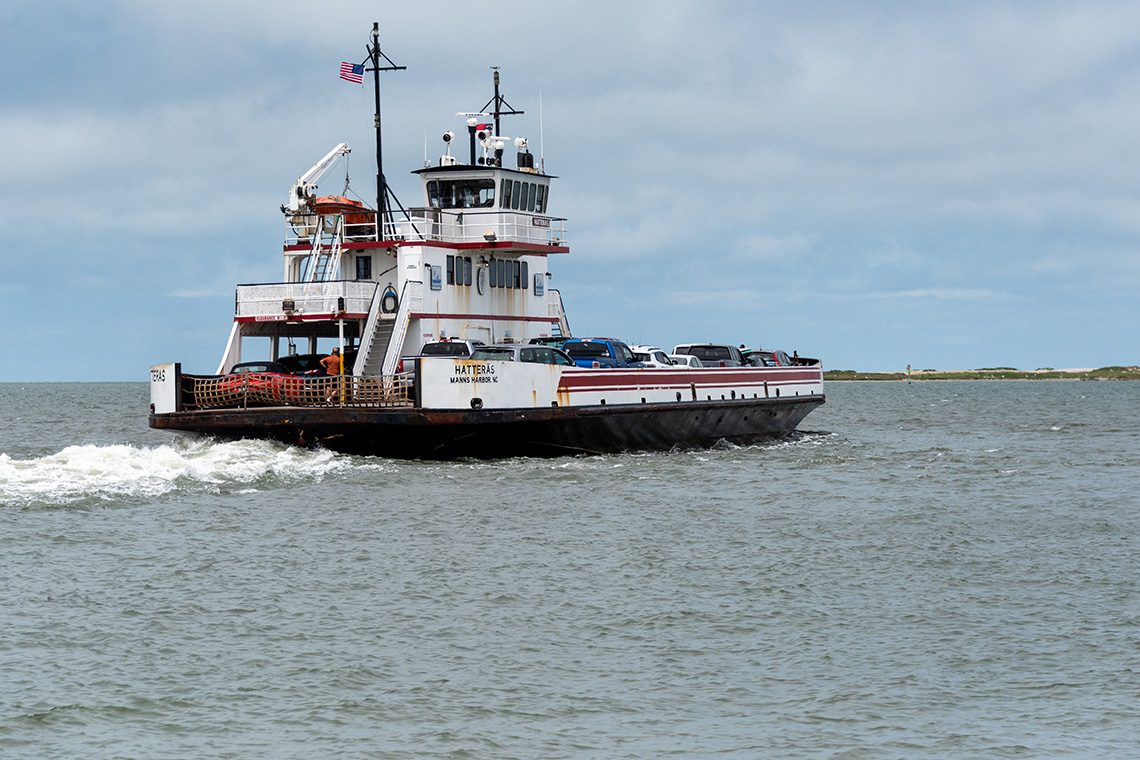NC Ferry Guide Sections:
- Swan Quarter - Ocracoke Ferry
- Cedar Island - Ocracoke Ferry
- Hatteras - Ocracoke Ferry
- Currituck - Knotts Island Ferry
- Other Routes
- Privately-Run Ferries
- Emergency Routes
- General Information
- Tips
- History of the Ferries
Check Official NCDOT Ferry Schedules and Fees
Decades ago, one of the only ways to access some of the most secluded areas of the Outer Banks was via a ferry, and this tradition carries on today for thousands if not millions of visitors who want to travel to some of coastal North Carolina's most famous and off-the-map locales.

A small handful of islands on the Outer Banks, specifically Knotts Island, Ocracoke Island and Portsmouth Island, are veritably cut off from the rest of the world. With no roads that cross over the Currituck or Pamlico Sound, these regions can only be accessed by boat, making them dependent on the NC Ferry system for transportation on and off the islands.
Thankfully, after decades of operation, the North Carolina Department of Transpiration (NCDOT) has ferry operations down to a science, with daily operations that rarely skip a beat, and hundreds of trips occurring every day throughout seven coastal North Carolina routes.
Four of these routes can be found along the Outer Banks, and allow visitors to access portions of these barrier islands that would otherwise be unobtainable without a private boat or plane. With reasonable fees (if any) and regularly scheduled runs, everyone is advised to make a ferry trip a fun part of their upcoming OBX vacation. The trip is generally just as entertaining as the destination, and thanks to the NCDOT's ferry system, everyone has access to some of the Outer Bank's most pristine and treasured destinations.
Swan Quarter Ferry
The Swan Quarter ferry is actually the longest of the seven North Carolina routes, and travels 2.5 hours across the quiet Pamlico Sound to Ocracoke Island. The closest "big" towns to Swan Quarter include Bath, Washington, and Belhaven, which makes this route one of the most secluded in the Outer Banks. As such, the route generally only has between 2-4 crossings per day from either side, which typically run from the early morning hours to about 4 or 4:30 in the afternoon.
Reservations are strongly recommended in advance to ensure a spot at one of the limited crossings, and can be obtained by calling 1-800-BY-FERRY or online at https://ferry.ncdot.gov/. You'll need a credit card to make reservations, and rates range from $1 to about $50 per trip, depending on the type of vehicle crossing. Most families in a typical 2-axel vehicle can expect to pay about $15 for a Pamlico Sound crossing.
Both the Swan Quarter and Ocracoke Island terminals, in addition to the ferry itself, offer vending machines and public restrooms so passengers can load up on snacks and drinks to enjoy during the excursion across the sound. In addition, because the Swan Quarter ferry utilizes the Sound Class ferry, (the largest available), the ship itself is well-equipped with air conditioned passenger lounges with comfortable seats, additional restrooms, and plenty of room to spread out. A peaceful excursion, the Swan Quarter ferry is rarely full, and is an ideal mode of transport for travelers who want to relax away from the crowds, and enjoy the ride.

Cedar Island Ferry
Like the Swan Quarter ferry, the Cedar Island is a Sound Class ferry route with a long crossing time that is approximately 2.25 hours from the NC mainland to Ocracoke Island and back. The Cedar Island ferry terminal is a scenic 30-45 minute drive away from other North Carolina coastal attractions and classic towns, including Beaufort, Morehead City and Emerald Isle, making it a popular spot for road-trippers who are exploring the entirety of the coastline.
Both the Cedar Island and Ocracoke ferry terminals offer vending machines, restrooms, and visitors' centers with gift shops, area information, and reading material to enjoy during the crossing. In addition, the Cedar Island terminal is adjacent to a small locally run motel and restaurant, so passengers with a long wait before the next ride have plenty of scenic options to bide their time. The soundside beaches along Cedar Island are beautiful and can easily be explored via a number of sand paths that are located just yards away from the terminal itself. Just be sure not to get too distracted and miss your boat altogether.
The Cedar Island ferry is one of the main routes for Ocracoke and even Hatteras Island vacationers traveling from the western and southern portions of the country, and as a result, the number of routes offered throughout the day varies greatly. In the dead of winter, the ferry generally has 3 runs from either side, while in the much busier summer months, travelers can select from up to 6 or 7 daily runs. Advanced reservations are strongly encouraged and can be made over the phone at 1-800-BY-FERRY or by booking online. Because of its proximity to major roads and more populated NC towns and cities, this ferry has a tendency to fill-up fast, so a little preparation will guarantee a nice, enjoyable ride across the Pamlico Sound and back.

Hatteras / Ocracoke Ferry
The Hatteras / Ocracoke Ferry is easily the most popular of the Outer Banks ferry routes as it provides transportation to thousands of day-trippers every summer who want to explore Ocracoke's gorgeous beaches, eclectic shops and art galleries, and fantastic waterfront restaurants.
The ferry is a completely fun part of any Ocracoke or Hatteras Island-hopping adventure, as the 40-45 minute shuttle across the Hatteras Inlet provides spectacular views of the Hatteras soundside beaches, the small handful of sandbar islands, and the inlet facing beaches of Ocracoke Island. The ferry is free to the public and loads on a first come, first serve basis - no reservations required - with the order only interrupted by essential personnel with priority passes.
Unlike the Swan Quarter and Cedar Island Ocracoke terminal, which is located on the southern end of the island and features an extensive visitors' center, vending machines, and access to some of the area's best restaurants and motels, the Ocracoke ferry terminal on this route is located on the unpopulated northern end the island. As such, resources here are limited to a bank of vending machines, public restrooms, and small sandy paths that lead out to sound or ocean facing beaches adjacent to the ferry waiting lines. For most passengers, this is more than enough, as even on a busy ferry traffic day, the unpopulated beaches of Ocracoke Island are waiting just around the dunes.
The Hatteras side of this route is another story altogether. This terminal borders the Hatteras Landing shopping center, a plaza which features a collection of gift shops, boutiques, apparel shops and restaurants, and which can be quickly and happily explored while waiting in line. A NCDOT Ferry visitors' station with vending machines, public restrooms and area information is located on the other side of the ferry parking lanes, so passengers can refuel and explore area information before departure.
The short ride is scenic and entertaining for visitors of all ages, with regular runs every 30 minutes in the summer season and every hour in the off-season. For a total exploration of the different cultures of the Outer Banks, an Ocracoke day trip via the Hatteras / Ocracoke ferry will allow visitors to access an entirely new coastal world, while making the journey an essential part of the fun.
Below is the new Ocracoke Express ferry offering ticketed rides for passengers and bicycles between Hatteras Village and Ocracoke Village. More information here.

Currituck / Knotts Island Ferry
Currituck mainland and northern Outer Banks visitors may want to spread their wings and take a day trip to Knotts Island, a small community that's located in the middle of the Currituck Sound, in between the popular beaches of Corolla and the busy mainland communities of Poplar Grove, Currituck, and Barco.
Knotts Island is a dominantly residential community with mainly year-round homes or second homes dotting the landscape. That said, the area is also adjacent to Mackey's Island National Wildlife Refuge, in addition to some fantastic boating and kayaking routes that lead directly to Corolla and the northern Carova beaches.
The day trip to Knotts Island is an essential trip for nature lovers, boat lovers, or anyone who likes to see the day-to-day operations of a small coastal community. Because of the hardy local population, in addition to the local tourism which is steadily growing, up to six ferries depart from either side throughout the day. The highest number of ferries cross during the weekdays, Monday through Friday, while 4-5 ferries run on the weekends providing transport to visitors and locals alike.
The ferry crossing takes approximately 45 minutes and can be easily accessed by following the ferry signs along US 158 close to the Virginia border. Public restrooms are available at both terminals, and while reservations are not allowed, showing up early is strongly recommended. On days with great weather, the route can become popular, so day-trippers are advised to show up early, (very early - the first crossing of the day begins at 6:00 a.m. from the mainland), to ensure a spot aboard.

Other Coastal North Carolina Ferry Routes
Though technically not part of the Outer Banks, visitors should be advised that there are three other routes that service other regions of the North Carolina coastline. These routes include the Bayview / Aurora ferry, the Cherry Branch / Minnesott Beach ferry, and the Southport/Fort Fisher Ferry. All of these routes are free crossings, run in between 20-45 minutes, and connect visitors to parts of the mainland that are divided by deep channels of salt water.
There are no reservations required for any of these three ferries, and there are regular crossings that generally depart every 15-60 minutes, so coastal explorers who want to stick close to the water will find plenty of routes to explore.
Privately Run Ferries
The days of privately run tug boats scooting across Oregon Inlet are long gone, but there are still a handful of privately run ferries in operation that provide essential transport to some of the North Carolina coastline's most pristine destinations. One such locale is Portsmouth Island, which can only be reached by a privately run tour group departing from Ocracoke Island, or a privately run ferry boat departing from Cedar Island.
The most famous of these routes is the Morris Marina ferry, which with permission from the National Park Service, provides transportation for vehicles and pedestrians alike to the northern beaches of Portsmouth Island. A fee is generally involved for the crossing, as well as reservations days if not weeks in advance, however adventurous Outer Banks vacationers find the expenditures and the extra planning well worth it. The beaches here are only frequented by visitors who take the involved steps to get there, meaning there are miles of unexplored shoreline to enjoy.
For a walking trip around the Cape Lookout Lighthouse, or to bring your 4WD truck to the relatively undiscovered beaches of Portsmouth Island and tour the miles-long island in its entirety, be sure and review your privately run ferry options. In the old days, the adventurous vacationers used privately run ferries to explore the unknown and less-travelled parts of the Outer Banks, and happily today, this is still generally the case.
Emergency Ferry Routes
Sometimes, when a hurricane or significant coastal storm hinders the use of the roads or bridges on or off the Outer Banks, an emergency ferry route is established to provide easier transport to locals, homeowners, and even visitors.
One of the most notable examples of the emergency ferry route is the Stumpy Point ferry route that came into play for the weeks that followed Hurricane Irene in 2011. After Irene, a large section of NC Highway 12 along Hatteras Island was deemed impassable, and as a result, and emergency ferry was set-up that ran from the Hatteras Island town of Rodanthe to the village of Swan Quarter, a town in the Dare County mainland that is approximately 15 miles southwest of Manteo.
In the event of a storm, emergency ferries may be open for visitors' use. Usually, there is a hierarchy involved, allowing homeowners and locals first access to the island, followed by visitors. Additional routes are also often added to established ferry runs, like the Swan Quarter or Cedar Island routes, ensuring everyone can enjoy their vacation despite a recent storm.
In the rare event that your vacation, or your preferred route on and off the islands, is affected by a hurricane, simply check with your vacation rental company to see what travel options are available. Considering that a long ferry ride is considered relaxing by the majority of passengers, a slight detour after a bit of worrying about the recent storm might be just the thing to put you back into vacation mode.
North Carolina Ferry General Info
While every ferry crossing is certainly different, there are a few universal rules and guidelines that every ferry passenger should keep in mind before heading on board.
All seven routes accept vehicles of all sizes, (generally up to 30' feet or so), so above all else, make sure your vehicle is "street legal," with proper tags and registration, and make sure you have a valid driver's license. In the past decade, the NC ferry system has made routine checks of IDs and licenses as part of the Homeland Security Program, so travelers are advised to have these identification forms handy at all times. (If you are travelling to the Outer Banks from another country, you should also bring your passport along to board the ferry, just in case there is a random check.)
Regardless of where you're departing or where you're landing, every ferry route sticks to a strict schedule, so showing up on time is essential. This is especially important for longer routes with an hour or more of travel time where reservations may be required, as if you miss your boat, you'll have to wait around for the next one. Depending on the ferry and the number of vehicles that can be accommodated, boarding time may take place anywhere from 5 minutes to 20 minutes before actual departure time, so its best to arrive early, and travel on the safe side.
The NC Ferry System operates three classes of ferries that are used in specific routes depending on the travel time, shallowness of the body of water itself, and the number of regular vehicles that frequent the route.
The smallest class in the Hatteras Class, which can often be spotted at local Knotts Island and Hatteras / Ocracoke ferry routes, where crossing shallow sound waters is an everyday routine. These boats draft less than 4' feet, and are built to travel through shallow or shifting sound floors. There are currently nine boats total that fit under this class, most of which can be found at the Hatteras / Ocracoke ferry docks. While these are generally smaller vessels, accommodating 30 vehicles at the most, they are generally more than adequate to tackle the busy summer southern Outer Banks traffic.
An estimated eight ferries fall under the River Class, a medium class of ferries that are resilient to heavy repeated abuse from rough inlet or sound waves, but can still navigate through shallow waters with ease. These ferries are slowly replacing the Hatteras Class as the popularity of Hatteras and Ocracoke Island grows, and today several River Class ferries service the Ocracoke / Hatteras routes. Currently, the NC Ferry System has 8 River Class ferries total, which serve a number of routes, although Hatteras / Ocracoke ferry passengers should lookout for the Stanford White or the Croatan, both of which make regular appearances during high traffic days. These ferries can carry up to 42 vehicles, which makes them instrumental for a higher volume of transport on busy holiday or summer weekends.
The largest group of ferries, the Sound Class, also has the smallest number of ships serving the routes. Just six vessels fall under the Sound Class distinction, and these vessels are reserved for the longest crossings along the Outer Banks, specifically the Swan Quarter and Cedar Island routes. With the ability to carry up to 50 vehicles and withstand hours on end of navigating through choppy salty sound waters, these ferries are easily the hardiest of the bunch.
Ferry travelers who are interested in what vessel they are taking to their destination of choice will notice small signs along either side, as well as small detailed color schemes which pays homage to a local North Carolina university. From the purple and gold for the East Carolina University pirates to the Carolina blue colors of UNC Chapel Hill, every major university in North Carolina is represented along the 24+ ships that travel regularly throughout the coastal region. Keep your eyes peeled for the name of your boat, the school, and the class for an in-person look at the different classes and types of vessels that serve the diverse regions of the Outer Banks.
Every ferry operated by the NCDOT has a bare minimum of amenities available to passengers to make their trip more enjoyable and a stress-free venture. Every ferry has public restrooms, a climate-controlled passenger lounge of varying sizes, and life boats and life jackets available for all passengers. In addition, all ferries have a strict set of rules for passengers travelling across the open waters. There is no smoking, and no alcohol allowed on any part of any NC ferry. In addition, vehicles and passengers must follow instructions of the NCDOT ferry personnel, not enter the captain's area or engine rooms, (and observe the roped off areas), and basically adhere to common sense at all times. In other words, don't try to dive off the boat, don't try to drive off the ferry until it's docked, and generally ensure that you and your crew have a fantastic time while on board.
The other great thing that every ferry route has in common is fantastic views. This is exactly why a ferry trip isn't an arduous part of the journey, but a destination in itself. Many Ocracoke or Knotts Island day trippers attest that the journey is a large chunk of the fun, so passengers via every route are encouraged to relax and enjoy the ride. With unparalleled views of the open water, and not to mention no driving or traffic to compete with, a ferry ride can be a relaxing way to start a coastal tour, an afternoon excursion, or a full-blown week of vacation.
While perusing the local ferry terminals and departure times, visitors will soon discover that every ferry route is different, from length of travel time to destination, or ferry fare to number of runs per day. This diversity is simply an indication of how varied the routes are, how time consuming, and how popular a destination or local route may be. For specifics on a particular route, passengers should take the following into consideration, and make their travel plans accordingly. A trip from Hatteras to Ocracoke Island is much different than a subsequent trip from Ocracoke to Cedar Island, and travelers should review the distinctions, and base their planning on each specific ferry route.
Tips and Tricks for riding the Outer Banks Ferries
- When possible, try to book a ferry crossing around sunset. There are no better views of the Pamlico or Currituck Sound than the ones found via a boat on the open water, and the local ferries provide this service for a bare minimum cost. Bring your camera, and don't be afraid to gather the family starboard or portside for some gorgeous pictures that will definitely make the family photo album.
- If you're on a midday departure, bring a little sunscreen, especially if you plan on lounging on the outdoor passenger deck. The sun reflects off the water surrounding the vessel, which makes many passengers susceptible to a nasty sunburn within minutes without even realizing it. Even if you plan to stay below decks or in the passenger lounge, better safe than sorry. A small coating of sunscreen before you arrive at your Outer Banks destination will surely ensure a good vacation to follow.
- Remember to follow the local rules as instructed by the local NC ferry personnel. Have your ID handy before and during boarding, set your parking brake and turn your engine off once you're on board, and don't smoke or drink alcohol once on the ferry. Once these guidelines are taken care of, sit back and enjoy the ride. For many passengers, the trip is part of the fun, especially when the trip entails skimming across the open sound waters on a 30-50 vehicle ferry which features air conditioned passenger lounges, vending machines, and unparalleled views of the Outer Banks.
- While ferry schedules are generally set in stone, be sure and note any changes due to extreme shoaling, wind conditions, or emergency ferry routes. Changes to the set schedule are rare, however, a strong nor'easter or imminent hurricane puts the NCDOT ferry operations on hold, and visitors should monitor the NCDOT's website at http://www.ncdot.gov/ferry/ for updates on ferry route changes in case of an emergency.
- Take along some grub. Believe it or not, a long ferry trip, like the Swan Quarter or Cedar Island routes, can be a perfect excuse to enjoy a meal on the go, and there are a number of fast dining options that can give you ample fare to enjoy on the trip. With the larger ferries featuring extensive passenger lounges that include a handful of diner-style tables, you can enjoy a gorgeous waterfront meal without all the frills or extra cost with a well packed picnic basket, to-go container, or cooler.
- Certain days can have more traffic than others on the ferries. For example, the Hatteras / Ocracoke route is usually very busy on summer weekdays, especially on Mondays - Thursdays when a number of local Outer banks visitors plan a daytime day trip. The Cedar Island ferry, on the other hand, generally has more ferry traffic on the weekends when visitors are arriving to or leaving their destination. It can be hard to determine which days will be busiest, but a good rule of thumb is to depart early or late. Midday traffic is generally always a little busier than the early morning or evening hours.
- Above all else, don't forget to have fun. A two hour ferry crossing across the open waters of the Pamlico Sound can be an ideal time to engage in a board game, a round of poker, or a couple chapters in a well-deserved beach read. Enjoy the ride, the lack of traffic and four-lane highways, and the process of delving into a laid back, vacation state of mind.
The NCDOT Ferry System has certainly grown from its early rots as a state subsidized venture helping the locals and sparse visitors find a way from one island to another. Today, the 24 ferries transport hundreds if north thousands of vehicles daily to a variety of locations all along the North Carolina coastline.
Thankfully, that same element of wonder and excitement that has always come with crossing a salty body of water to get to your vacation destination still remains, and modern vacationers, (even seasoned ones), find themselves just as enthralled with a slow moving trip across the sound as they were on their first adventure.
Bring along a camera, a pair of binoculars, a book, an arsenal of snacks, or whatever you need to ease you into a vacation state of mind. Chances are the open Currituck or Pamlico Sound waters, combined with the nice break from away from the car, will make you ready to enjoy the beach life, Outer Banks style.
History of the Outer Banks Ferris
The North Carolina Ferry System, which is managed by the NCDOT, has humble roots that belies its' current count of 24 ferries, more than 400 workers, and hundreds of daily runs. Many longtime Outer Banks locals can point to the private operations of Captain J.B. (Toby) Tillet as the instrumental transport that put the current ferry operations on its track.
In the 1920s, there were policies in place by the North Carolina DOT recognizing that ferries would have to be implemented by the state to provide transport to areas that could not be serviced by roads, (locally, Ocracoke , Hatteras and Knotts Islands.) But even while the NCDOT began to identify these areas, ferry transportation was already in full swing, run by local entrepreneurs who had both tug boats that could accommodate vehicles, as well as enough time to provide regular service from the islands to the mainland.
The most notable of these private ferry captains was Capt. Tillet, an Outer Banks native who hauled both locals and visitors alike across Oregon Inlet via a tug boat and a barge, allowing access on and off Hatteras Island. Many local historians argue that it was Capt. Tillet who first opened up Hatteras Island for tourism, as avid duck hunters and fishermen would travel to the southern Outer Banks from as far away as New England to make the long trek to some fantastic waterfowl hunting grounds and surfside fishing. Thanks to Capt. Tillet, the trip was actually accessible, and the southern Outer Banks slowly gained a reputation as being one of the best natural beach destinations in the world.
Other privately run ferry services popped up all along the coastline, including one to Knotts Island, and several to the southern Cape Lookout National Seashore, but on the Outer Banks, Tillet's service seemed to have the most regular traffic. Bear in mind that even in the 1920s, Hatteras Island had a hardy local population of well over 1,000 people across all seven villages, who needed to leave the island from time to time.
Taking note of this business, and the fact that Capt. Tillet was struggling to both keep up with the increase in traffic and maintain fares at an affordable level, the NC Highway Commission began to subsidize the route in order to keep tolls affordable. In 1942, the Commission began a full-reimbursement program to eliminate tolls altogether, and by 1950 the business was completely sold to the state.
During this timeframe from the 1920s to the 1950s, other privately-run regular routes were subsidized or bought outright to keep the fares low or nonexistent. In fact, the honor of first ferry route actually goes to a former passage than ran across the Croatan Sound. In 1947, the Highway Commission purchased the ferry operations of T.A. Baum, three years before Tillet's Oregon Inlet route was fully state run, and provided a connection between Roanoke Island and Manns Harbor. But it was Tillet's route that both exemplified the necessity of reliable ferry transportation on the Outer Banks, and also introduced new Outer Banks vacationers to the incredible beaches of Hatteras Island.
Over the years, certain routes became obsolete as bridges were built, providing even easier transport to and from the islands. The original T.A. Baum route was replaced by the Manns Harbor Bridge and later the Virginia Dare Memorial Bridge, while the Oregon Inlet route was disposed of in 1963 upon the grand opening of the Herbert C. Bonner Bridge.
That said, there are areas of North Carolina that due to National Park Service guidelines, tumultuous inlets, or generally unbuildable waters, will predictably always require the services of a state-run ferry system. Thankfully, since its first route in 1947 to the seven coastal routes it manages today, the local ferry system shows no signs of letting its off-the-beaten-path Outer Banks local and visiting passengers down.



























